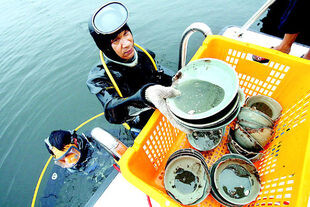hankyoreh
Links to other country sites 다른 나라 사이트 링크
Porcelain estimated to be 850 years old is found under the sea

The largest underwater discovery of Goryeo dynasty period (918-1392) porcelain, or celadon, has been found amidst the wreckage of an ancient ship, just off the west coast of Taean, South Chungnam province, the Cultural Heritage Administration announced on Tuesday.
The remains of a Goryeo-era traditional ship that had been carrying a large shipment of celadon was found between Daeseom and Hyeongjeseom islands off of Geunheung-myeon, Jeongjuk-ri in Taean, in water 9 meters deep and spread across a 7.7 by 7.4-meter area. Researchers on the boat that [[is leading the excavation ]]] have reportedly said that 2,000 porcelain works can be seen by the naked eye and that the ship’s structure suggests there could be as many as 6,000 to 10,000 porcelain items in the wreckage.
The heritage administration said that part of the wreckage site has been viewed by Seoul National University professor of shipbuilding science Choe Hang-sun, who said that the ship may have been as long as 20 meters in length with seven planks, meaning that there could ultimately be as many as 30,000 works of Goryeo celadon, as the porcelain is known in English, may have been on board.
Items that have been brought to the surface as samples of what lies beneath the water include dishes, bowls, a teapot in the shape of a melon, tea bowls and other items. These items are typical of what is estimated by Myongji University professor of porcelain history Yun Yong-I to have been found in the middle or late 12th century. He says the ship was on its way from Gangjin, South Jolla province, where it was produced, to Gaeseong, the capital of the Goryeo kingdom, and that while the items are not of the absolute highest quality, they are at least of the quality that might have been used in government centers and by the aristocracy.
There have been fourteen discoveries of porcelain off of Korea’s West Coast. One in 1976 near Sinan produced 22,000 items, but most of it had been produced in Yuan China. Roughly 30,000 items were discovered at another site located off the coast of the island of Wando, South Jeolla province, in 1983, but most were not of high quality. The search for this latest discovery began after a fisherman caught some porcelain in one of his traps, instead of the jukkumi, or octopus ocellatus, he had been looking for.
The Cultural Heritage Administration’s Yu Hong-jun said that the discovery is like opening an 850-year-old time capsule and will serve as precious material in the study of the development of Korean celadon and the history of Korean shipbuilding and maritime life. CHA officials said that the excavation of the celadon will continue until November and that all the remains of the boat itself will be raised as well.
Editorial・opinion
![[Column] Has Korea, too, crossed the Rubicon on China? [Column] Has Korea, too, crossed the Rubicon on China?](https://flexible.img.hani.co.kr/flexible/normal/500/300/imgdb/original/2024/0419/9317135153409185.jpg) [Column] Has Korea, too, crossed the Rubicon on China?
[Column] Has Korea, too, crossed the Rubicon on China?![[Correspondent’s column] In Japan’s alliance with US, echoes of its past alliances with UK [Correspondent’s column] In Japan’s alliance with US, echoes of its past alliances with UK](https://flexible.img.hani.co.kr/flexible/normal/500/300/imgdb/original/2024/0419/2317135166563519.jpg) [Correspondent’s column] In Japan’s alliance with US, echoes of its past alliances with UK
[Correspondent’s column] In Japan’s alliance with US, echoes of its past alliances with UK- [Editorial] Does Yoon think the Korean public is wrong?
- [Editorial] As it bolsters its alliance with US, Japan must be accountable for past
- [Guest essay] Amending the Constitution is Yoon’s key to leaving office in public’s good graces
- [Editorial] 10 years on, lessons of Sewol tragedy must never be forgotten
- [Column] A death blow to Korea’s prosecutor politics
- [Correspondent’s column] The US and the end of Japanese pacifism
- [Guest essay] How Korea turned its trainee doctors into monsters
- [Guest essay] As someone who helped forge Seoul-Moscow ties, their status today troubles me
Most viewed articles
- 1[Column] The clock is ticking for Korea’s first lady
- 2Samsung barricades office as unionized workers strike for better conditions
- 3After 2 months of delayed, denied medical care, Koreans worry worst may be yet to come
- 4[Correspondent’s column] In Japan’s alliance with US, echoes of its past alliances with UK
- 5[Column] Has Korea, too, crossed the Rubicon on China?
- 6Hong Se-hwa, voice for tolerance whose memoir of exile touched a chord, dies at 76
- 7[Photo] Smile ambassador, you’re on camera
- 8All eyes on Xiaomi after it pulls off EV that Apple couldn’t
- 9[Guest essay] How Korea turned its trainee doctors into monsters
- 10US overtakes China as Korea’s top export market, prompting trade sanction jitters